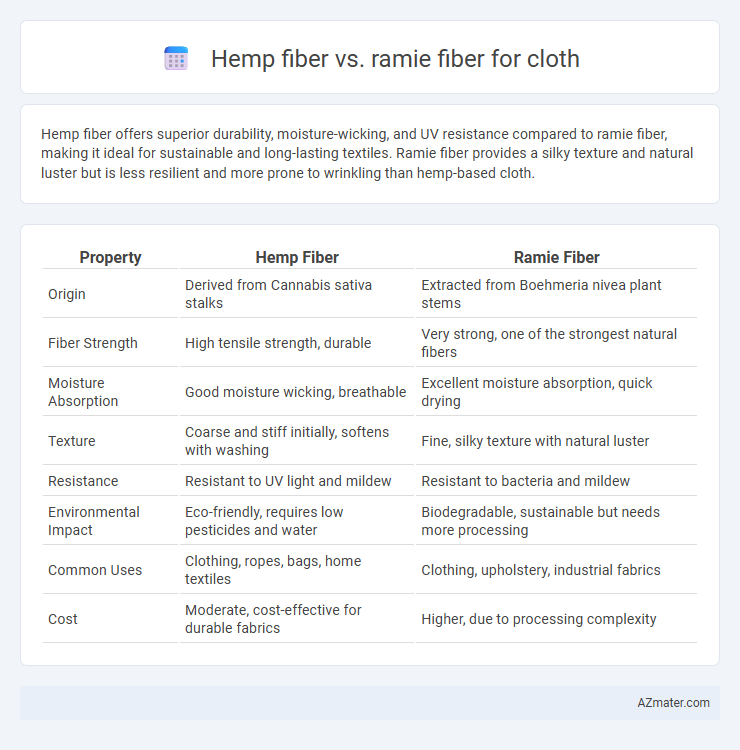Hemp fiber offers superior durability, moisture-wicking, and UV resistance compared to ramie fiber, making it ideal for sustainable and long-lasting textiles. Ramie fiber provides a silky texture and natural luster but is less resilient and more prone to wrinkling than hemp-based cloth.
Table of Comparison
| Property | Hemp Fiber | Ramie Fiber |
|---|---|---|
| Origin | Derived from Cannabis sativa stalks | Extracted from Boehmeria nivea plant stems |
| Fiber Strength | High tensile strength, durable | Very strong, one of the strongest natural fibers |
| Moisture Absorption | Good moisture wicking, breathable | Excellent moisture absorption, quick drying |
| Texture | Coarse and stiff initially, softens with washing | Fine, silky texture with natural luster |
| Resistance | Resistant to UV light and mildew | Resistant to bacteria and mildew |
| Environmental Impact | Eco-friendly, requires low pesticides and water | Biodegradable, sustainable but needs more processing |
| Common Uses | Clothing, ropes, bags, home textiles | Clothing, upholstery, industrial fabrics |
| Cost | Moderate, cost-effective for durable fabrics | Higher, due to processing complexity |
Introduction to Hemp and Ramie Fibers
Hemp fiber, derived from the stalks of the Cannabis sativa plant, is known for its durability, breathability, and resistance to mold and UV rays, making it a sustainable choice for eco-friendly textiles. Ramie fiber, obtained from the stalks of the Boehmeria nitens plant, boasts a silky luster, excellent absorbency, and high tensile strength, often blended with other fibers to enhance fabric texture and durability. Both fibers are biodegradable and natural, with hemp offering superior toughness while ramie provides a smoother finish, catering to diverse clothing applications.
Botanical Origins and History
Hemp fiber originates from the Cannabis sativa plant, historically cultivated for over 10,000 years due to its strong, durable qualities and versatility in textiles. Ramie fiber is derived from the Boehmeria nivea plant, a flowering species native to East Asia, with cultivation dating back more than 6,000 years primarily in China. Both fibers have played significant roles in traditional fabric production, with hemp known for its coarse texture and ramie valued for its silky luster and resistance to microbial attacks.
Fiber Extraction and Processing Methods
Hemp fiber extraction involves retting, where microbial action breaks down pectins to separate fibers, followed by decortication to remove woody parts, ensuring durable and coarse textile fibers ideal for coarse fabrics. Ramie fiber processing requires degumming, a crucial step that removes gummy pectins using chemical or enzymatic treatments, producing lustrous, fine, and smooth fibers suitable for high-quality cloth. Both fibers demand specialized extraction techniques to preserve fiber integrity, but hemp emphasizes retting and mechanical separation, while ramie focuses on chemical degumming for fiber refinement.
Physical Properties Comparison
Hemp fiber exhibits higher tensile strength and durability compared to ramie fiber, making it more suitable for heavy-duty fabric applications. Ramie fiber offers superior luster and a smoother texture, enhancing the aesthetic quality of garments but with lower elasticity. Both fibers provide excellent moisture absorption, yet hemp tends to retain more strength when wet, contributing to longer-lasting cloth performance.
Environmental Impact and Sustainability
Hemp fiber outperforms ramie fiber in environmental impact due to its rapid growth rate, minimal pesticide use, and high carbon sequestration capacity, making it highly sustainable for textile production. Ramie fiber, while biodegradable and requiring fewer chemicals than cotton, involves energy-intensive degumming processes that increase its environmental footprint. The renewable nature of hemp combined with its low water requirements establishes it as a more eco-friendly choice for sustainable clothing fibers.
Durability and Strength Analysis
Hemp fiber exhibits superior strength with a tensile strength of approximately 550 MPa, surpassing ramie's average tensile strength of around 400 MPa, making hemp highly durable for cloth applications. Both fibers resist stretching and maintain shape well, but hemp's resistance to wear and environmental stressors enhances its longevity in textiles. Ramie offers good strength but is more brittle and less elastic compared to hemp, resulting in lower durability under frequent mechanical stress.
Comfort and Breathability in Clothing
Hemp fiber, known for its durability and moisture-wicking properties, offers superior breathability and a natural softness that enhances comfort in clothing. Ramie fiber boasts a smooth texture and excellent moisture absorbency, providing a lightweight and cool feel ideal for warm climates. Both fibers contribute to breathable, comfortable textiles, with hemp excelling in strength and breathability, while ramie stands out for its silky softness and effective moisture management.
Dyeability and Fabric Finishing
Hemp fiber exhibits excellent dye absorption due to its porous structure, allowing vibrant and long-lasting colors, while Ramie fiber, though less absorbent, produces a smooth and lustrous finish ideal for high-quality fabrics. Fabric finishing of hemp involves processes that enhance softness and flexibility, making it suitable for durable textiles, whereas Ramie requires specialized treatments to reduce stiffness and enhance sheen, resulting in elegant garments. Both fibers respond well to natural and synthetic dyes, but hemp offers superior compatibility with eco-friendly dyeing techniques, making it preferable for sustainable fashion applications.
Cost and Market Availability
Hemp fiber is generally more cost-effective than ramie fiber due to its faster growth cycle and higher yield per acre, making it a popular choice in sustainable textile markets. Ramie fiber, while offering superior luster and strength, tends to be more expensive and less widely available due to labor-intensive processing and limited cultivation areas. The market availability of hemp fiber is rapidly expanding globally, supported by growing demand in eco-friendly fabrics, whereas ramie remains niche with steady but comparatively lower commercial presence.
Applications in Modern Textile Industry
Hemp fiber offers exceptional durability, breathability, and antimicrobial properties, making it ideal for sustainable fashion, upholstery, and technical textiles in the modern industry. Ramie fiber provides a silky luster, high tensile strength, and excellent moisture absorption, frequently used in blended fabrics, sportswear, and home textiles to enhance texture and comfort. Both fibers contribute to eco-friendly textile production, with hemp favored for heavy-duty applications and ramie preferred for lightweight, delicate fabrics.

Infographic: Hemp fiber vs Ramie fiber for Cloth
 azmater.com
azmater.com